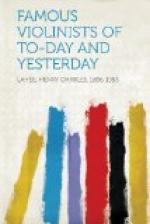These, however, were amateurs, and the earliest professional violinist known was Mrs. Sarah Ottey, who was born about 1695, and who about 1721-22 performed frequently at concerts, giving solos on the harpsichord, violin, and bass viol. Previous to her there was one Signora Leonora Baroni, born at Mantua about 1610, but she played the theorbo and the viol di gamba.
The next is “La Diamantina,” born about 1715, who is referred to by the poet Gray in 1740, when he was at Rome, as “a famous virtuosa, played on the violin divinely, and sung angelically.”
Anne Nicholl, born in England about 1728, played the violin before the Duke of Cumberland at Huntley in 1746, and her granddaughter, Mary Anne Paton, also, who was better known as a singer and who became Lady Lenox, and afterwards Mrs. Wood, was a violinist.
The celebrated Madame Gertrude Elizabeth Mara, one of the greatest singers of her time, was a violinist when young. Her father took her to England, hoping by means of her playing to get sufficient money to give her a thorough musical education. She was then a mere child, and as she grew to womanhood her voice developed and she became one of the celebrities in the history of song. There is no doubt that the training in intervals which her practice on the violin gave her proved invaluable as an aid to her in singing. In later days several of the most celebrated singers have been also good violinists, as, for instance, Christine Nilsson and Marcella Sembrich.
Maddalena Lombardi Sirmen, born about 1735, had an almost European reputation toward the end of the eighteenth century. She visited France and England about 1760-61, and was so good a player that she was looked upon almost as a rival of Nardini. She will always be celebrated in history because of the letter which was written to her by Tartini, and which is not only one of the rarities of musical literature, but constitutes also a valuable treatise on the use of the violin.
This letter, which has been printed in almost every book on the violin, would take up rather more space than can be afforded in this sketch. It is admirably clear and is divided into three parts, the first giving advice on bowing, “pressing the bow lightly but steadily, upon the strings in such a manner as that it shall seem to breathe the first tone it gives, which must proceed from the friction of the string, and not from percussion, as by a blow given with a hammer upon it,—if the tone is begun with delicacy, there is little danger of rendering it afterwards either coarse or harsh.” The second section of the letter is devoted to the finger-board, or the “carriage of the left hand,” and the last part to the “shake.”
Maddalena Sirmen received her instruction first at the conservatory of Mendicanti at Venice, after which she took lessons from Tartini. She also composed a considerable quantity of violin music, much of which was published at Amsterdam. About 1782 she, emulating the example of Madame Mara, appeared as a singer at Dresden, but with comparatively small success.




